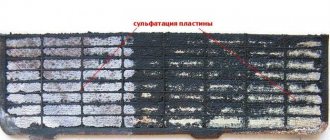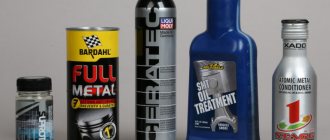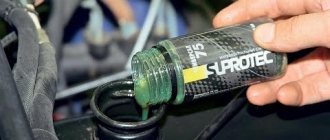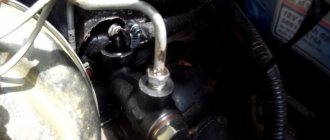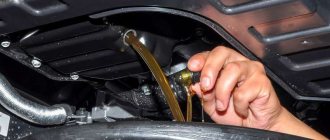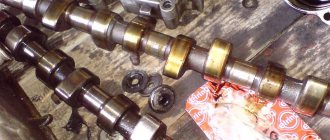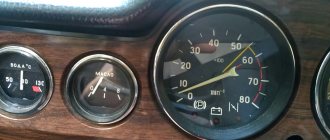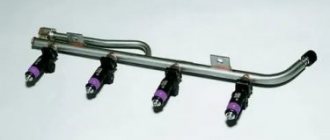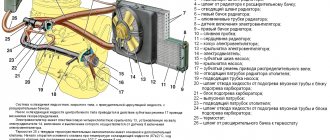Why is dirt under the hood dangerous?
A car's engine is its heart. Even small accumulations of dirt and oil can cause it to malfunction. First of all, pollution affects the thermal regulation of the engine. As you know, the power unit largely consists of metal elements. Thus, layers of dirt and oil accumulating on the walls of its elements can contribute to overheating. In addition, there is also a radiator in the engine compartment, which is responsible for cooling the engine. Large layers of dirt, dust, and insects accumulated on the radiator honeycomb will disrupt the heat exchange process.
Argument from fans of car engine washing
A dirty motor overheats much faster, since a layer of dust, dirt and oil impairs heat transfer, thereby forming some kind of thermal insulation. Where the wiring connectors are poorly protected, dirt will accumulate over time, and this already smacks of a short circuit with a variety of ensuing consequences, from a failed fuse to a burning car.
In addition, when the engine is washed, it is much easier to detect oil leaks and the consequences of abnormal engine operation. And a simply dirty engine is not aesthetically pleasing.
How to safely wash a car engine. Pressure and hand washing
When there is a lot of dirt, snow and puddles on the roads, all this gets into the engine compartment and settles on the units. Solid particles, including not only soil, but also substances formed during the combustion of fuel, oil, as well as road reagents, form sediment over the years. Such layering not only does not look aesthetically pleasing, but also impairs the performance of some components and assemblies.
Some car owners prefer to wash their engines themselves, others prefer to go to a car wash, but there are those who are afraid to go under the hood to clean them, and they really have reasons to be afraid. How do you wash the engine and do you wash it at all? Write in the comments
.
Today I will talk about ways in which you can wash your engine safely!
What are the dangers of a dirty car engine and how to wash it properly?
Seeing the title of the article, a car enthusiast will most likely ask the question: why do you need to wash the engine at all? It is worth noting that this is not a mandatory action, since the technical characteristics of the car do not change dramatically depending on the degree of cleanliness of the engine. Of course, there are some risks that timely cleaning and washing of the above mechanism will eliminate. Although, if you are constantly haunted by Moidodyr and you rub the engine compartment and everything else until it shines, it certainly won’t make things worse. Let's talk about the disadvantages hidden behind the dirt. First of all, dirt on the engine reduces its heat transfer, which can lead to overheating. And this will lead to a decrease in power and increased fuel costs, and the wear process will accelerate. Also, an engine covered with a layer of dirt will not allow the driver to effectively control the likely leakage of oil, coolants and other technical fluids. If the motorist does not notice something is wrong in time, the problems may become more serious. The formation of dirty build-ups on the electrical wiring will make it difficult to start the engine, because some of the current will be lost. Finally, the fire hazard increases significantly when the owner does not take care of engine cleanliness. An oil leak will be followed by its evaporation, forming flammable vapors that can instantly lead to a fire. Of course, there are also aesthetic arguments - some workshops even refuse to repair cars when the mechanisms are extremely dirty. And it’s more pleasant to look under the hood and see a clean engine. The conclusion is clear: you need to wash it periodically. How to properly wash the engine yourself? Pressurized water should not be used for these purposes. Such rough impact will damage the insulation, may initiate corrosion in the generator and other parts, and damage the paint. Compressed air will not be an effective solution, since it will not eliminate contamination in hard-to-reach areas. So, the best way is to use a weak stream of water, as well as appropriate chemicals. Do not try to clean the engine using household detergents! They are useless against motor oil. A proper washing process should look like this. Take polyethylene and insulate all parts that should not be wet - connectors, air intake, generator. Warm up the engine a little (it shouldn't be particularly hot) and turn it off. Don't forget to remove the battery! Apply special auto chemicals to the engine, wait a few minutes for the detergent to deal with the contamination. Rinse off the dissolved dirt with a weak stream of water, dry the mechanisms using a compressor or vacuum cleaner. In hard-to-reach places you will have to use a stiff brush. At the end of the procedure, be sure to wipe all parts with a rag. It is enough to carry out such actions once a year.
R93 – Autoportal of the Krasnodar region: Auto reviews
Tweet
Share
Share
Cool
Preparing to wash a car engine
- Before washing the engine, you need to close all sensors, relays and other devices for which you do not want water to enter. Aluminum foil is perfect for this. It masks the engine elements and stays in place well. The foil takes the shape of the parts wrapped in it and does not interfere when cleaning the engine.
- You need to spray regular clean water on the parts around the engine compartment. This will make it easier to wash off engine cleaner from adjacent parts that may get on them when washing the engine compartment and engine. If this is not done, the dried product will leave marks that are not easy to wash off.
- Do not wash a hot engine. It is better to plan a wash after the engine has completely cooled down. To loosen oil and dirt accumulated on the engine and its components, it is best to warm up the engine for a few minutes until it is warm. The best temperature for washing the engine is such that the engine is warm to the touch.
Why wash the engine
A dirty engine is not harmful to a car. Other than that, there are no strict washing instructions. So why do some still prefer to clean the engine? The reasons are as follows:
- The dirt covering it will not allow you to see the leak of technical fluids, and this can lead to overheating or difficulties with heat transfer.
- The consequence of this will be a loss of necessary characteristics and increased fuel consumption.
- The end result is rapid wear and tear.
- Dirt on electrical wiring can prevent the engine from starting properly and can lead to current leakage.
- Increased fire hazard from a contaminated engine.
- A clean product is easier to process.
What causes excessive engine contamination?
An unkempt power unit and its attachments can cause a lot of trouble:
- engine overheating;
- engine tripping;
- short circuit in electrical wiring;
- revs are difficult to gain;
- acceleration of wear processes of engine working elements;
- increased fuel consumption;
- uneven movement of the car.
After washing the engine the car does not start, what should I do?
During the engine washing process, unpleasant and unnoticeable breakdowns may occur or water may enter electrical appliances, so the car may not start.
- If after washing the engine the car does not start, then you first need to inspect the spark plug channels, electrical connectors, generator, starter. If moisture is detected, parts must be thoroughly wiped or dried.
- Problems with engine operation can occur if the electrical circuit is broken. This could be a forgotten connector chip that was disconnected before washing, or an awkward movement by a motorist that led to a broken wire.
- If after washing the engine the car does not start, and the Check Engine light comes on on the instrument panel, then it will be quite easy to figure out the reasons for this yourself using the ELM327 auto scanner.
For those motorists who do not have free time or do not like to tinker with the car, the best option, in our opinion, would be to visit a car wash. Professionals will do the job of cleaning the engine compartment quickly and efficiently, and the driver won’t even get his hands dirty. In any case, washing the engine once or twice a year is within the capabilities and means of every car owner.
How to wash a car engine - let's start the procedure
This procedure can also be carried out at home, for this you need: a special engine washing agent, a dryer or vacuum cleaner, a dishwashing sponge, a thick bag, aluminum foil, a toothbrush or a small brush, several dry towels, baking soda and access to water . The engine should not be very hot, otherwise the cleaning agent will quickly dry out on it, and you will have to treat the surface again.
First, you need to remove the terminals from the battery and protect the air intake from water, to do this you need to put a bag on it and seal it tightly with tape, in the same way you should protect the battery, distributor and other electrical parts. Otherwise, you may notice the sad fact that after washing the engine the car starts to shake. It will be difficult to fix this, so it is worth thinking about caution in advance.
Next, apply detergent to the surface and leave for a while (it should be indicated in the instructions). Scrub the surface with a dish sponge; in hard-to-reach places, a toothbrush or thin brush may be useful. Now rinse with water, but the pressure should not be strong. Then it would be a good idea to thoroughly dry the unit using a dryer; if one is not available, then you can use an ordinary vacuum cleaner, just set it to blowing mode.
As a last resort, you can simply leave the engine to dry in the sun for 5 minutes, and then start it and let it run for 15 minutes, while keeping the hood open.
The battery still needs to be treated. Remove it from the bag and wipe thoroughly with a soda solution (1:1 soda and water). Then treat it with a damp towel and wipe dry. If you are afraid of damaging the engine, then you need to dry wash the car engine yourself; for this you should purchase a special product such as Poly Wash. The idea is simple: apply the product to the motor, wipe it with a microfiber cloth, polish it with a second cloth and thereby wipe it dry.
Precautionary measures
The chemical composition of specialized products is unsafe, so the user must remember some handling rules:
- It is required to protect the respiratory system - use a mask (respirator), wear gloves;
- It is advisable to use sleeves;
- safety glasses required;
- work uniform.
The drugs splash, contact with the skin or eyes is unacceptable, as they provoke inflammation or allergic reactions. Clothes can be damaged by oil stains from the engine compartment.
How to wash a car engine
After preparation, you can start washing. But for this you still need to choose the right tool. It should not harm the material from which the block and other parts are made, and also remove all oil deposits without any problems. Such substances are sold in any car store and are not very expensive, that is, there will be no problems with selection and purchase.
Engine cleaning products are many and varied.
Therefore, it’s easier to say what not to wash the engine, what products can harm it and what not. To find out, you also need to consider what material it is made of. Most often, the engine block is made of cast iron or aluminum alloy, therefore, it cannot be exposed to acid , which is found in large quantities in various products. You also need to be careful with plastic parts so as not to spoil them.
are NOT RECOMMENDED for washing the engine , as they are ineffective or dangerous:
- Dishwashing liquid. The worst and most hopeless option, since it cannot cope with machine oil.
- Gasoline, kerosene, diesel fuel and other flammable substances. Many people use them for cleaning due to the fact that they are powerful solvents. Once in the oil, it acquires the consistency of water, which means that removing it from the surface of the engine will not be difficult. However, they are all highly flammable, which puts an end to their effectiveness. If after the procedure there is even a drop of such a substance left under the hood, then a fire is guaranteed. In addition, solvents have a negative effect on plastic products.
- Water. A pointless waste of time that will yield no results at all.
An engine detergent should dissolve oil well and not contain acid in its composition, and also be safe and non-flammable. Almost all specialized liquids that are sold in a spare parts store have such properties. That is, in order to wash the engine quickly and without problems, it is best to buy the product.
How to properly wash a car engine at home
The process of washing a car engine can be divided into two main stages: preparatory work and the washing itself. The final result directly depends on the thoroughness of each operation.
Preparing the engine for washing
Before you spray the engine compartment with a generous layer of cleaning solution, there are several important preparatory procedures that need to be completed. At first glance, they seem unnecessary and time-consuming, but the benefits of these operations will be enormous, because after washing you will not have to dry wiring, electrical appliances and other parts for a long time.
- First of all, you need to disconnect the negative terminal from the battery.
- Wiring areas with joints, sensors, generator and connectors should be protected from moisture using plastic film and tape.
- It is highly advisable to remove the engine crankcase and gearbox protection for free access to the lower part of the engine.
If necessary, you also need to disconnect those components and parts that interfere with access to the engine.
Procedure for washing a car engine
Each engine cleaner comes with detailed instructions for use. You must read it carefully and follow the manufacturer's recommendations.
Most often, the procedure for washing an engine is as follows.
- A thick layer of dirt is first removed from the engine housing with a screwdriver, scraper or spatula.
- Dry detergent is dissolved in warm water.
- The resulting solution is applied to the surface of the motor using a suitable brush or sprayed from a pneumatic gun.
- After this, within 10-20 minutes (the exact time is indicated in the instructions), the detergent should soften or dissolve the dirt.
- While the product is working, you need to carefully go over hard-to-reach areas of the engine with a small brush.
- After the waiting time has expired, the cleaning solution is washed off the engine with a stream of water or wiped with a wet brush.
- If necessary, the cleaning operation must be repeated in those places where contaminants remain.
After washing the engine, it is imperative to dry the electrical wiring and electrical appliances that are located under the hood. Now the insulation can be removed and all removed components and parts can be installed.
Before starting the engine, do not forget to connect the negative terminal to the battery. If there is powdery deposits on the leads and terminals, remove it with fine sandpaper.
To prevent corrosion of the metal parts of the battery, you can prepare a solution of soda in water in a 1:1 ratio. Treatment is carried out with a moistened rag or swab. After chemical treatment, the battery should be dried.
After starting the engine, pay attention to the operation of the power unit: the engine should operate evenly without dips throughout the entire speed range.
Engine washing methods
When the question of how to wash a car engine has been decided, let’s decide how to do it. And here are some common methods :
- Dry cleaning . Use liquid or foam in an aerosol can. There is no need to rinse with water after applying the substance. Before using such a product, it is necessary to warm up the engine , but not to a too hot state. If you apply the product to a cold engine, cleaning will not be effective. It is prohibited to apply to some parts of the internal combustion engine; this is indicated in the instructions. The process itself is also very labor-intensive.
- Steam washing . This professional method is not suitable for home use. Only a specialist knows how to properly wash and not damage the engine.
- Karcher . Not the safest method of contactless cleaning. High pressure water can damage some parts of the internal combustion engine. A small amount of liquid can also get inside the motor and cause damage or corrosion.
- Rinse with water . A special cleaning agent is first applied. After some time, it is simply washed off with a stream of water. This method is the most common, but does not protect against moisture getting into the motor.
The engine compartment needs to be flushed only once a year.
Engine problems after washing
Sometimes after washing, various problems arise in the operation of the power plant, which are expressed as follows:
- the engine does not start or stalls;
- the engine is unstable (idle speed fluctuates, there are twitches);
- the oil pressure light comes on;
- "check" is on.
If, after washing the unit, all electrical connections are restored, the starter turns and the fuel pump runs, but the engine does not start, then attention should be paid to the following:
- on cars equipped with an ignition distributor, you need to get rid of water under the distributor cover by wiping or blowing. They also dry the high-voltage wires, turn out and inspect the spark plugs, and remove moisture from the spark plug wells;
- on machines in which the ignition coils are installed separately for each cylinder, you need to dismantle and dry each part separately. Otherwise, perform actions similar to the previous paragraph;
- when the engine stalls (one of the cylinders does not work), a drop in power is felt, and the operation of the unit is accompanied by strong vibration. In addition, twitching of the car itself is possible. The most common reasons for this behavior are possible due to problems with the ignition system discussed in the first paragraph. If drying does not help, the reasons may be due to a malfunction of one of the motor sensors;
- if the speed fluctuates, this indicates problems with the throttle valve or its position sensor. In this case, cleaning and drying of the elements is required, as well as disconnecting the battery terminals for 10–15 minutes;
- The oil pressure light on the dashboard may come on due to moisture getting on the oil sensor itself or its contacts;
- The “check” indication indicates a malfunction of the motor. The fault can be determined only after diagnosing the unit by reading errors from the computer at a service center.
If the check light comes on, this indicates a problem with the engine.
Sometimes problems that arise after washing the engine go away on their own as a result of the unit completely drying.
How to properly wash a car under the hood
A thick layer of dirt that accumulates on the outer walls of the engine during operation is not only an aesthetically unpleasant sight, but also a direct threat of breakdowns, fires due to overheating, and various malfunctions. Therefore, on average, the engine compartment should be washed once every 10–12 months.
Preparation
Before starting the process, the car engine is prepared as follows:
- Remove all protective and decorative plastic parts and screens accessible for dismantling.
- Information plates and inscriptions on tanks and body elements are sealed with waterproof material.
- De-energize the electrical wiring. Ideally, the battery is also removed.
- Cover air intakes, connectors, terminals, and electrical equipment parts with polyethylene and tape.
You cannot wash a hot engine, as the chemical compounds will evaporate too quickly and their efficiency will be significantly reduced. The optimal temperature of the motor and water to achieve the best result is 40–50 degrees.
The process of washing the engine compartment
After preparing the work front, you can proceed directly to the washing process:
- Using a dry rag, remove the thickest layers of dirt and large debris from all accessible surfaces. You cannot start washing without removing, for example, dry leaves: they will get into the drainage holes and clog them during the next procedure.
- The motor is coated with a special cleaning agent and the time is waited for it to begin to corrode the dirt. Do not apply the cleaning liquid too liberally, otherwise it will take a long time to wash it off, and this will increase the risk of damage to the wiring.
- The engine is washed with a stream of water from a Karcher or a garden hose. When using the device, choose a gentle mode, since too high pressure will lead to damage to rubber and plastic parts and electrical wiring.
It is better to schedule engine washing for the warm season. In cold weather, even after drying, some liquid may remain on the moving parts of the motor and disrupt its operation.
Finish cleaning
The final stage of washing is evaluating the results and drying the engine. If some of the contaminants remain on the surface, it is worth repeating the chemical treatment procedure.
The last step in cleaning the engine is drying. At reputable service stations, this procedure is performed with a blow gun. At home, you can use a hair dryer, a compressor or a regular vacuum cleaner. First of all, the starter and generator are purged, then the ignition coils and all electrical wiring.
The final stage is washing the car body. Do not delay this procedure, as any remaining detergent must be removed, otherwise it will damage the coating.
After washing the car engine
All that remains is to dry the engine compartment after washing. First you need to remove the polyethylene. Then it would be ideal to blow out all the contacts with compressed air. But under normal conditions, start the engine with the hood open and let the car run outdoors for about 30 minutes.
After the engine has dried, measure its temperature again. Let us remind you that the dirty engine warmed up to 89°C. After washing, the operating temperature is 79°C.
When everything is ready, one more issue of aesthetics remains: plastic and rubber parts after washing look gray and unsightly. If you are preparing a car for sale, or enjoy observing the perfect cleanliness under the hood, take advantage of our advice. Take Tire and Bumper Ink. Apply it to a soft cloth and wipe all rubber and plastic parts.
Look, we treated half to show the difference with the untreated part of the engine compartment. Agree, it looks much more beautiful and more expensive.
Video of car engine washing
If the article was useful to you, share it with your friends. Ask your questions and suggest interesting topics for videos, articles and tests in our groups on social networks.
Source
Why wash your car engine?
Let’s talk specifically about the washing procedure carried out independently, since you and I know that at almost every car wash there is a warning “the administration is not responsible for the serviceability of the engine after washing.” In fact, it certainly does, but this is a legal issue. We will answer the question “is it necessary and whether it is possible to wash a car engine,” and also give advice on how to wash it yourself correctly.
Let's start with the fact that engine washing is mandatory, here are 5 reasons:
- To avoid current leakage. Leaks occur through contaminated contacts, resulting in rapid battery discharge.
- To avoid overheating. Dirt on the cylinder block causes the unit to cool worse. After washing the engine, the difference in operating temperature of a heated unit at idle speed can reach several tens of degrees.
- It becomes easier to notice oil and antifreeze leaks. If the cylinder block and valve cover are covered with a layer of dust, it is difficult to distinguish the age and nature of the stains.
- A clean engine compartment increases the value of your car and helps you sell it faster.
- The final fifth point is aesthetics. This is a personal matter for everyone, but we are pleased when it’s clean under the hood.
Drying the engine
After finishing the procedure, the washed engine compartment and the engine itself must be dried with a dry paper towel or rag. Moreover, if after this it is discovered that there are traces of corrosion on the elements of the engine and engine compartment, their locations must be cleaned using baking soda and water in a 1:1 ratio. The washed and treated engine should be started and run to check its performance.
Do-it-yourself engine washing
- Insulation with polyethylene of those things that may be damaged by humidity (applies to the generator, connectors, air filter intake and breaker distributor).
- Warming up the engine. Then turn it off and let it cool until it becomes warm (definitely not hot!).
- Now you need to remove the battery.
- Distribute the detergent over the surface of the engine, let it work with the dirt, and then rinse it off.
- Remove insulation and dry.
Apply cleaning agent
After the engine has warmed up a little and some elements have been protected from moisture, you can begin spraying the engine cleaner. Modern engine cleaning products act quickly and effectively. If the engine is not very dirty, then it is not advisable to use too aggressive products based on petroleum products or solvents. They quickly act on oil contaminants and stubborn dirt, but at the same time they destroy rubber tubes and plastic in the engine compartment. It is better to use water-based cleaners.
General purpose cleaners that can remove grease can be used.
Depending on how dirty the engine is, you need to let the cleaning agent soak into the dirt film for 3–10 minutes. Do not allow the cleaner to dry on the engine after spraying. This will leave traces of the product.
If the engine is not very dirty, then you can do without using a brush. In case of heavy contamination and stubborn dirt, it is better to use a brush with a long handle. For some hard-to-reach places, you can use a toothbrush.
After applying engine cleaner and, if necessary, using a brush, thoroughly rinse the engine and its components with water.
If you use a pressure washer, do not apply too much pressure or spray water too close to electrical connectors to avoid damaging them.
Allow the water to dry briefly, then wipe accessible engine parts and plastic parts with a clean rag before the water dries itself to avoid leaving any traces of dried water. After wiping with a dry cloth, start the engine and let it run for a few minutes. This will help the remaining moisture evaporate.
Once everything is dry and the engine has cooled, it would be a good idea to apply a special protective coating for the engine. You can also apply a protective coating to the engine compartment plastic and rubber tubes.
Useful tips
- Before using the detergent, you should carefully read the instructions .
- Be sure to first prepare the engine for washing.
- If possible, you should first remove dirt from the surface by wiping the engine with a rag.
- When washing a car with water, be sure to dry it with a compressor.
- Then you need to check the car . If it starts as usual, then everything was done correctly. If the motor stalls or extraneous noise appears, something went wrong during the washing process.
Cleanliness is the key to the health of the machine. The car enthusiast will be sure that the iron horse will not fail at the wrong moment. The main thing is to know how and with what to wash a car engine. Try to clean the engine of your iron horse at least once a year. Then many breakdowns can be avoided.


